Introduction
Updated 1/14/19: Retested and corrected poor uplink performance
ASUS and NETGEAR have no qualms about having early adopters and Wi-Fi naifs shell out big bucks for the honor of beta-testing their first draft 802.11ax/Wi-Fi 6 routers. But they have been in no hurry to get product to reviewers. So I took advantage of the generous holiday return policies during this most wonderful time of the year to get ASUS’ RT-AX88U and NETGEAR’s RAX80 in for testing.
This is not a full review of the products. Think of this more of a glimpse at what you may be in for if you opt to buy one of these science experiments right now. Both the products and the underlying technology are waaay too immature at this point to pretend this is the final word on their performance. I’m also in the process of a full revamp of the SmallNetBuilder router test process and will be changing software and hardware over the next few months.
I’ll still be using octoScope gear, including its Pal partner devices as the test client. But the test plan specifics will be different. So don’t look for any of these results in the Router Charts just yet.
The Products
Both the ASUS RT-AX88U AX6000 Dual Band 802.11ax WiFi Router and NETGEAR Nighthawk AX8 8-Stream AX6000 WiFi Router are built on essentially the same Broadcom platform, i.e. a Broadcom BCM49408 64 bit quad-core @ 1.8 GHz processor and two BCM43684 4 stream an/ac/ax radios.
I didn’t open up my borrowed samples, but gathered the information below from WikiDevi. The information is more complete for the ASUS since its FCC short-term confidentiality period has expired, but NETGEAR’s has not.
| ASUS RT-AX88U | NETGEAR RAX80 | |
|---|---|---|
| CPU | Broadcom BCM49408 64 bit quad-core @ 1.8 GHz | Broadcom BCM49408 64 bit quad-core @ 1.8 GHz |
| Switch | In CPU + BCM53134 | In CPU |
| RAM | 1024 MB | 512 MB |
| Flash | 256 MB | 256 MB |
| 2.4 GHz Radio | – Broadcom BCM43684 4-stream an/ac/ax radio – Skyworks SKY85216-11 2.4 GHz LNA (x4) – Skyworks SKY85006-11 2.4 GHz PA (x4) |
– Broadcom BCM43684 4-stream an/ac/ax radio |
| 5 GHz radio | – Broadcom BCM43684 4 stream an/ac/ax radio – Skyworks SKY85743-21 5 GHz front end (x4) |
– Broadcom BCM43684 4 stream an/ac/ax radio |
Table 1: Component summary
The main functional difference between the two is the Ethernet port LAN count and link aggregation support. The RT-AX88U has one WAN and eight LAN Gigabit Ethernet ports, with LAN ports 1 and 2 supporting 802.3ad link aggregation.
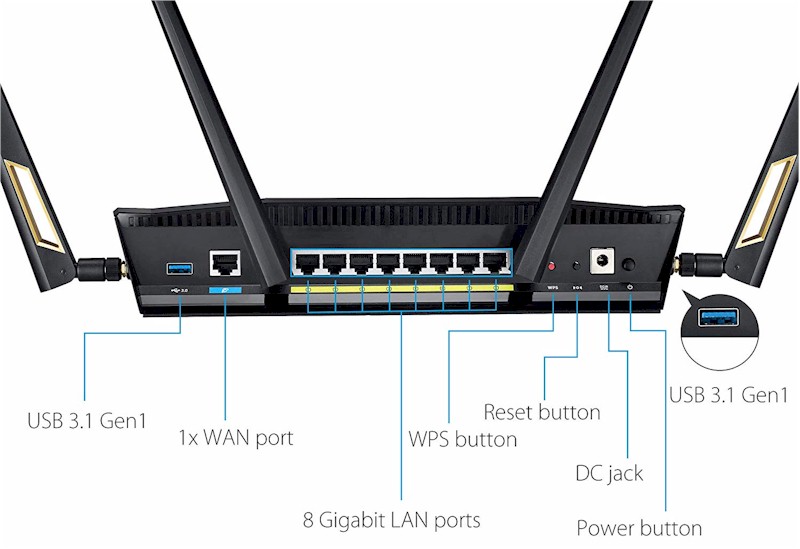
ASUS RT-AX88U rear callouts
The RAX80 has one Gigabit Ethernet WAN and five Gigabit LAN ports, but lets you switch one of the LAN ports to WAN and aggregate it (802.3ad) with the dedicated WAN port to work with some DOCSIS 3.1 cable modems that also support aggregated ports. You also can aggregate ports four and 5 on the LAN side.
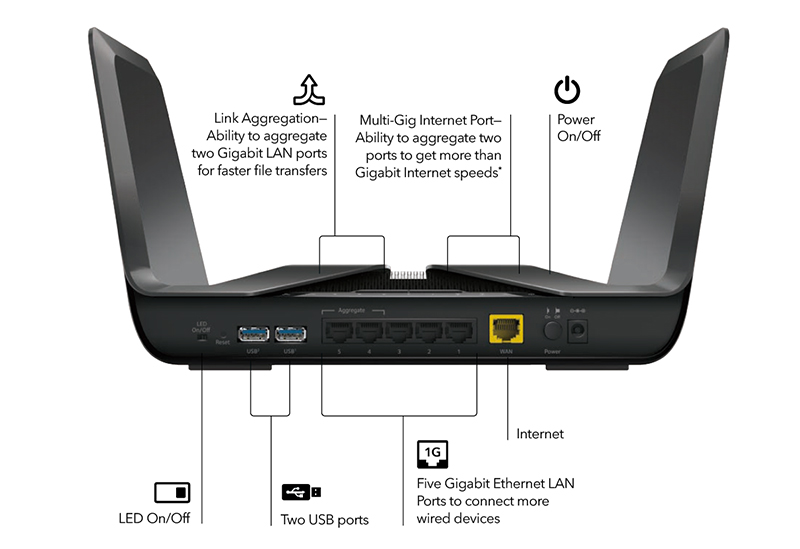
NETGEAR RAX80 rear callouts
Both products also have two USB 3 ports. ASUS specs theirs as USB 3.1 Gen 1; NETGEAR just says USB 3.0. And, oh yeah, the RAX80 has a fan (which I never heard spin up to an audible level); the RT-AX88U does not.
On the Wi-Fi side, both routers support the UNII-2 and 2e DFS channels shown below (in the U.S., at least). This means both support contiguous 160 MHz channels, assuming you don’t live close to an airport or other radar installation. Note that the Broadcom architecture does not support split 160 MHz channels (80+80). So don’t set your primary channel to 149 or higher if you want 160 MHz wide channels.
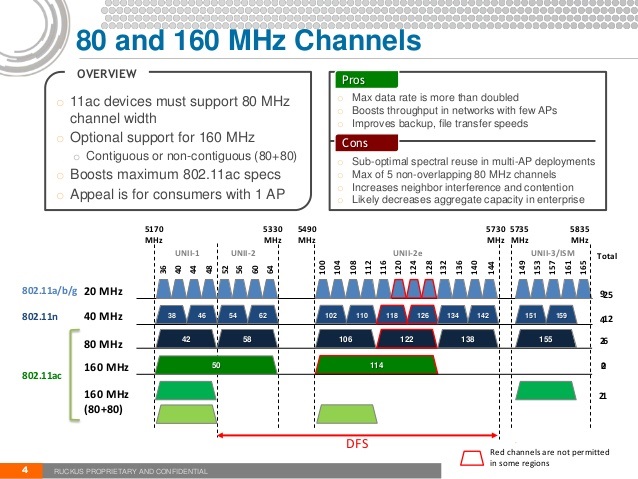
Image credit: Ruckus Wireless
Both products also let you disable the HE frame information that 802.11ax requires. ASUS asks you if you want to enable HE frames as part of its setup wizard, while NETGEAR just defaults to them disabled in the Advanced Wireless settings. Unlike in the R7800–the only 802.11ac router that supports 160 MHz wide channels–there is no HT 160 mode enable in the RAX80. If you want 160 MHz wide frames, just set the WiFi Mode selector to the Up to 4800 Mbps option. (Yes, that’s a new look for NETGEAR’s Genie GUI.)
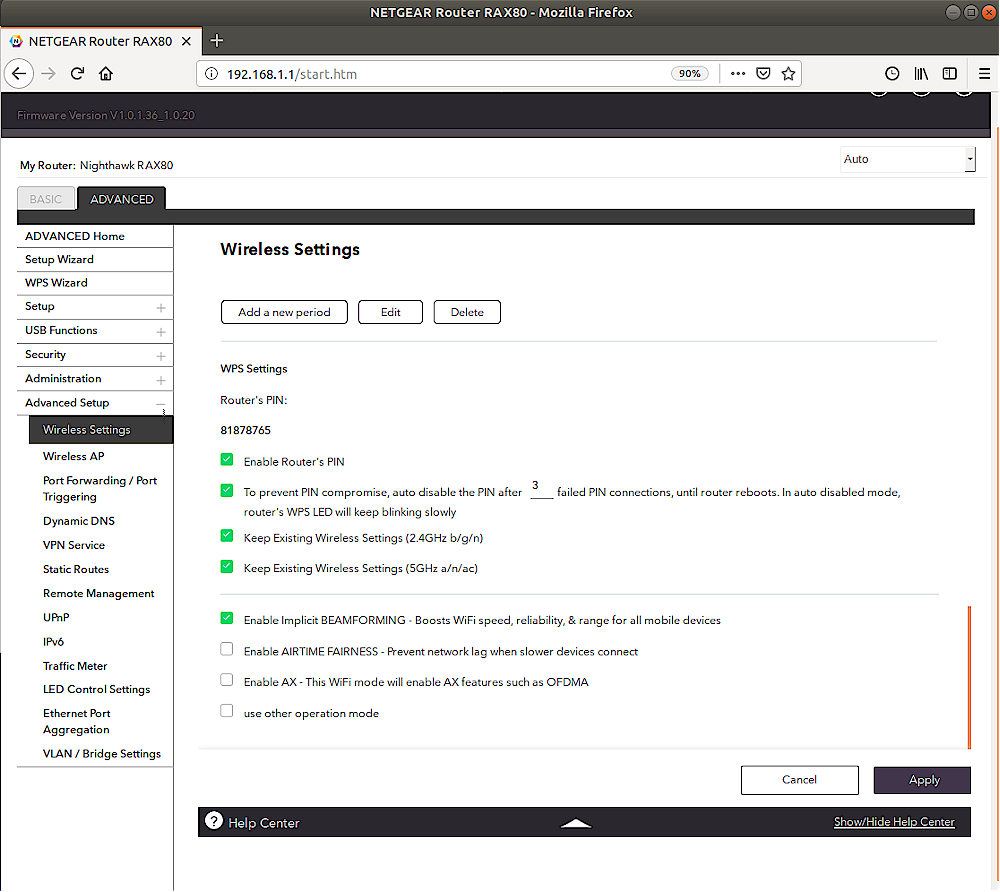
NETGEAR RAX80 advanced wireless settings defaults
As described in 5 Things To Know Before You Buy A Draft 11ax Router, the high link rates found in both products’ data sheets will be able to be achieved only by four-stream Wi-Fi 6 devices. For now, the only way to do this is with another draft 11ax router operating in bridge mode, which both products support.
For those of us with current-generation two-stream 11ac devices, you’ll see the same top link rates you get with your current AC router, i.e. 867 Mbps in 5 GHz and 400 Mbps in 2.4 GHz. The latter assumes you can run with 40 MHz wide channels in 2.4 GHz, which is unlikely in most cases. You’re more likely to see 173 Mbps as your top 2.4 GHz link rate.
The only folks with something to gain from early adopting this technology that still is in the Pampers stage of its life are those with a laptop/notebook with an Intel AC 9260 inside. This is the only client device that supports 160 MHz wide channels and it supports only two streams. It’s also an 802.11ac device. So if you have it and if you have the radar-free airspace required for a 160 MHz wide channel and if you are close to your router, then you should be able to see your link rate move from 867 to 1733 Mbps.
I upgraded my Intel XPS13 notebook with one and, yes, Windows reported a 1.7 Gbps link rate. But note that I first tried to install it in the Lenovo ThinkCentre Tiny M600 used in the Version 9 Wireless test process so that I could run direct-cabled tests. But try as I might, I could not get the Lenovo to recognize the card, even with it upgraded to Windows 10 and with the latest Intel drivers.
How We Tested
11ax is even more complex than 802.11ac and is still undergoing rapid change as bugs are found, tracked down and fixed. Both ASUS and NETGEAR said new firmware releases were coming soon and hinted at my holding off publishing results until I had those loaded up. But there’s going to be (or should be) a steady stream of releases over the next few months, so we have to start somewhere.
The goal of these tests is to assess the performance seen by a two-stream AC (aka Wi-Fi 5) device. I didn’t run any tests to see if the products could reach the maximum advertised 5 GHz 4804 Mbps link rates. Those numbers are primarily for marketing bragging rights and won’t be seen in normal use, even with two routers in a bridge situation. Achieving any practical benefit from such a bridge would also require multiple traffic sources and sinks. octoScope Pal-24 and Pal-5 partner devices were used as the test STAs. Both have Qualcomm QCA9984-based radios and support maximum 256 QAM modulation.
As is our practice, only released firmware was used for testing, 3.0.0.4.384_5247-g499251e for the ASUS and 1.0.1.36_1.0.20 for the NETGEAR.
HE frames were disabled on both products because they aren’t used by 11ac devices and are just another potential source of problems at this point. For each product, the 2.4 GHz radio was set to Channel 6 and whichever setting produced a 40 MHz wide channel. For 5 GHz, Channel 40 was set as primary and whichever settings produced a 160 MHz wide channel.
Each router was centered on the turntable in the main octoBox 38 test chamber, as shown below (yes, I know that photo is from the AC88U review). Unlike our Version 10 router process, the router was not rotated during the test. A single iperf3 TCP connection with unlimited bandwidth was used to generate traffic.
The only benchmarks run were Rate vs. Range (RvR). This is essentially the same test as the "Profile" test found in the Router Charts; I’m finally adopting more standard terminology. This test shows how throughput (rate) changes as signal level is varied (range). Instead of using physical distance to vary the signal by walking a laptop around my home, the router is placed in an RF-tight anechoic chamber (the octoBox) and programmable RF attenuators are used to change the signal. The diagram below from the Version 10 Wireless Test Process description shows the setup.
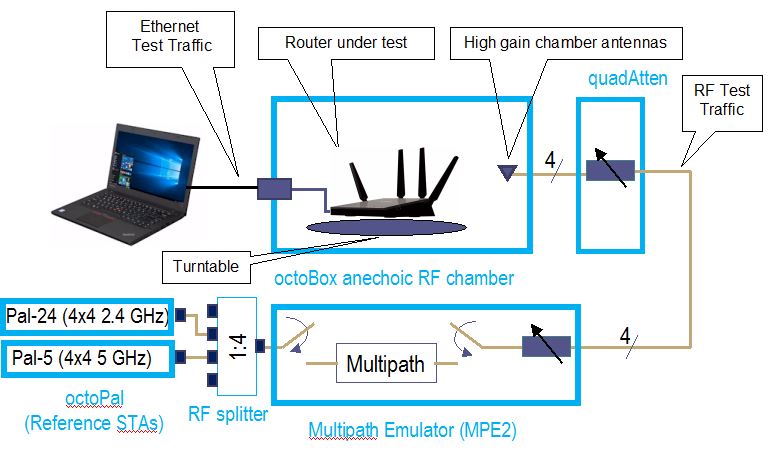
RvR test setup
For 2.4 GHz, the attenuation was ramped from 0 to 63 dB in 3 dB steps; for 5 GHz, the range was 0 to 45 dB in 3 dB steps. Each test ran traffic for 35 seconds with the first five seconds discarded from the test average. The test sequence was:
- 5 GHz @ 80 MHz downlink
- 5 GHz @ 80 MHz uplink
- 5 GHz @ 160 MHz downlink
- 5 GHz @ 160 MHz uplink
- 2.4 GHz @ 20 MHz downlink
- 2.4 GHz @ 20 MHz uplink
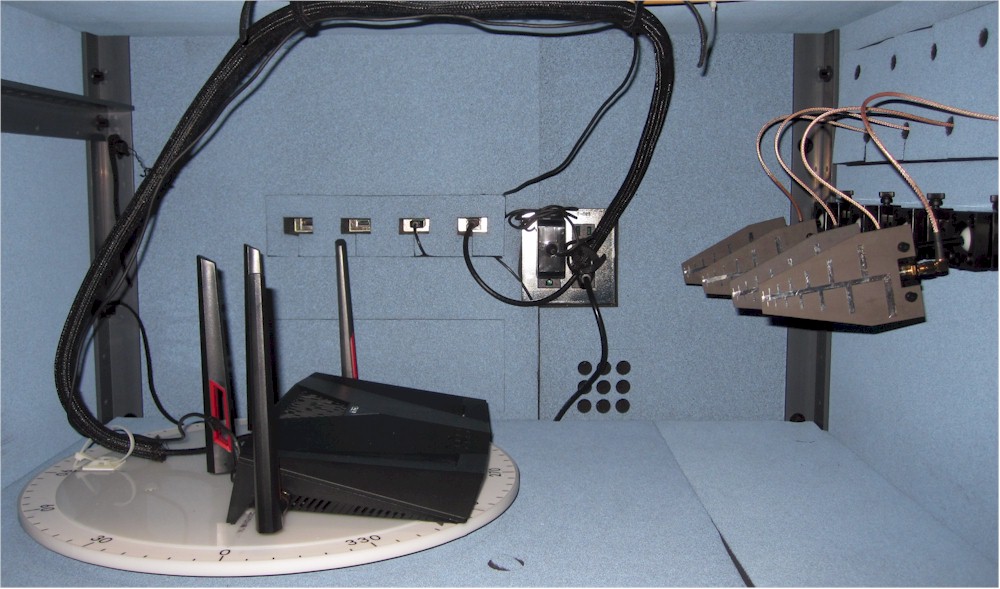
ASUS RT-AC88U in test chamber
When testing 2.4 GHz, the Pal STA bandwidth was set to 20 MHz, as is our practice. This reflects a more typical view of performance in this band due to the crowded airspace most users enounter.
For 5 GHz, two sets of tests were run: one with the Pal STA limited to 80 MHz maximum; and the second with it limited to 160 MHz. So we’ll get to see what sort of benefit wider channels can bring.
I ran at least two tests for each benchmark because some of the results were kind of wonky. I’ll be showing the better of the two runs.
For reference, I also retested NETGEAR’s R7800 with v1.0.2.60 firmware and HT 160 mode enabled. This is a four-stream AC2600 class router supporting both DFS and 160 MHz wide 5 GHz channels, using Qualcomm QCA9984 4×4 MU-MIMO-enabled 802.11ac radios on both bands. Since all you are getting right now by buying a draft 11ax router is the equivalent of a four stream AC router that supports DFS channels and 160 MHz channel bandwidth, it’s a good reference (and costs about $150 less).
Test Results – 2.4 GHz
Let’s get the easy stuff out of the way with 2.4 GHz. Remember these tests are with 20 MHz channel bandwidth.
In the downlink test, both draft AX devices out-perform the AC-based R7800 with around 10% higher peak throughput (145 Mbps) that doesn’t start to drop off until 9 dB more attenuation is applied. Both also have a tad more usable throughput than the R7800 at 63 dB of attenuation.
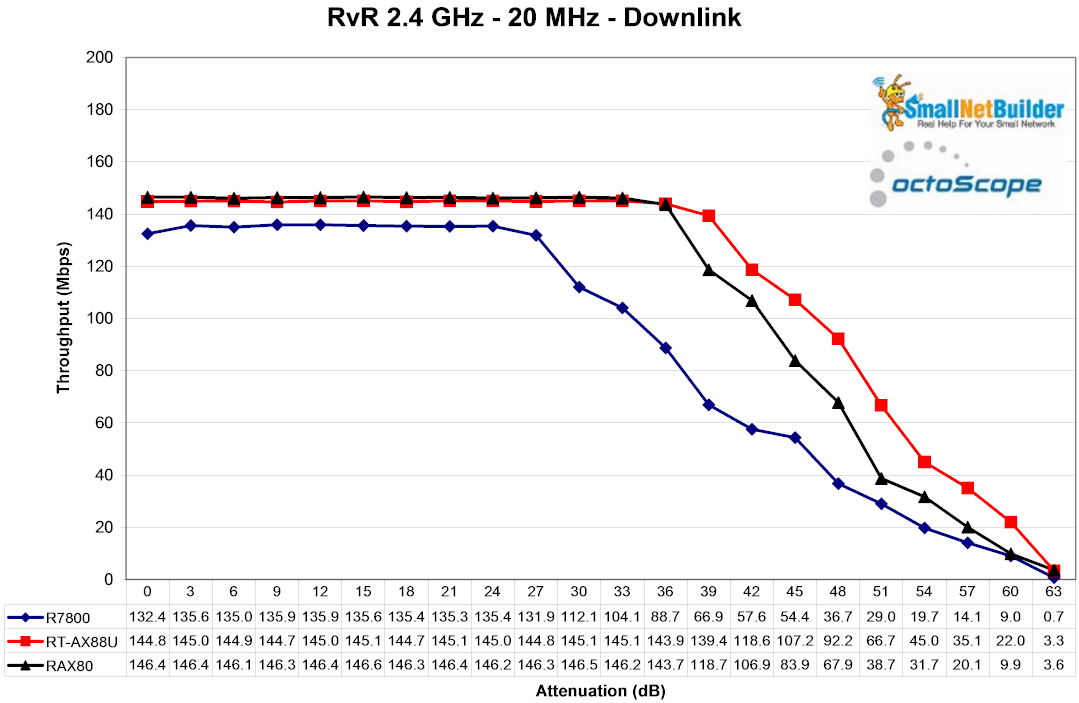
RvR 2.4 GHz – downlink
2.4 GHz uplink shows a different story. This time the R7800 and ASUS have the same peak throughput of around 130 Mbps, but the NETGEAR RAX80 is stuck down at 40 Mbps. This one was a bit of a puzzler, especially because Pal logs showed it was operating with an RSSI of around -30 dBm and maximum (173 Mbps) Tx and Rx link rates.
I eventually found that if the router was rebooted and the uplink test was run without first running the downlink test, it produced throughput similar to the other routers. So my conclusion is there’s something wonky in the RAX80 transmit rate adaptation that will need to be fixed in a future firmware update.
Update 1/14/19: After working with both Broadcom and NETGEAR, I have a better explanation of the low uplink performance. The bottom line is there is a known Broadcom / Qualcomm interoperability issue that is not specific to Broadcom’s 11ax chipset. I happened to stumble onto it because of two differences from my normal test method.
First, the router under test was not rotated while traffic was running during the test. This is meant to average out differences in product antenna design and to try to mitigate near-field effects from the small distance between DUT and STA. Rotation will be done in the finalized new test process.
Second, the Pal STA was not reassociated between downlink and uplink tests. Since the connection could have been broken under high attenuation conditions, the STA should have been reassociated to ensure it was properly connected. This will also be done in the finalized new process.
The low uplink throughput was caused by the STA’s packet aggregation becoming stuck at low aggregation when attenuation is high (low signal level) at the end of the downlink run, then not resetting to high aggregation when attenuation is reset to low (high signal level) to start the uplink test.
Reassociating the device between downlink and uplink runs causes packet aggregation to be properly reset.
New uplink plots showing both original and retest results for the RAX80 have been posted.
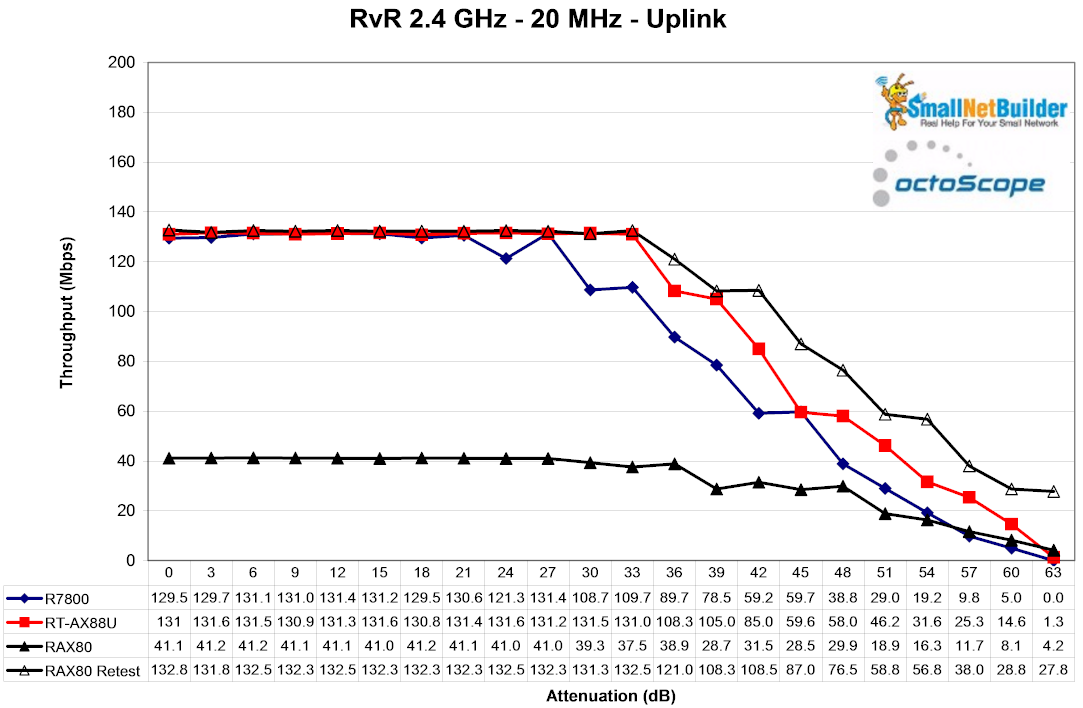
RETESTED RvR 2.4 GHz – uplink
Test Results – 5 GHz
Turning to the 5 GHz band, we’ll first look at downlink with 80 MHz channel width. Sorry that this plot is a little busy, but let’s deconstruct it. First, the better AX router in this benchmark is the ASUS; it has slightly higher peak throughput than the NETGEAR RAX80. More importantly, its throughput falls less steeply, at least until 30 dB of attenuation.
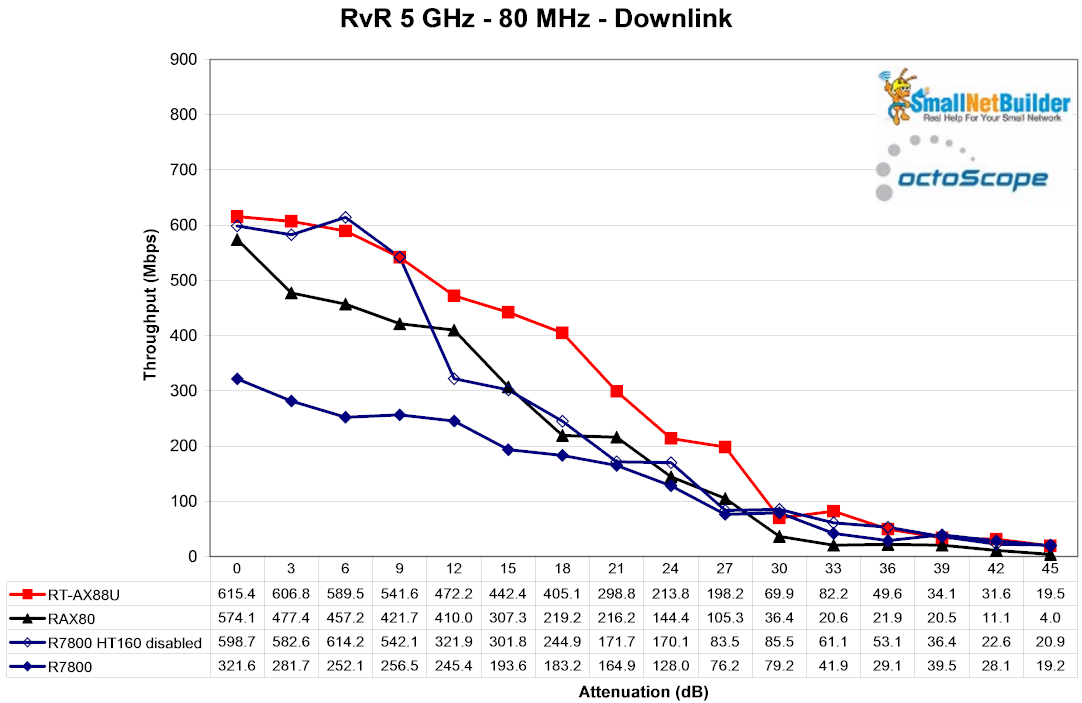
RvR 5 GHz – 80 MHz – downlink
So why the two plots for the NETGEAR R7800? This again required some detective work to explain why its throughput was significantly lower. This time, I traced it to HT 160 mode being enabled. When HT 160 was disabled, the R7800 behaved more like the draft AX routers. Since I did not have to do this for the other routers, including NETGEAR’s RAX80, I’d say NETGEAR has some more work to do on transmit rate management.
For uplink, the NETGEAR R7800, both with and without HT 160 mode enabled, has throughput up near 600 Mbps, where it should be. But the ASUS again turns in the best performance for pretty much the entire benchmark attenuation range.
The low RAX80 throughput? This is caused by the same mechanism demonstrated in 2.4 GHz uplink. The plot below has been updated to show original and retested uplink results for the RAX80, as per the explanation above.
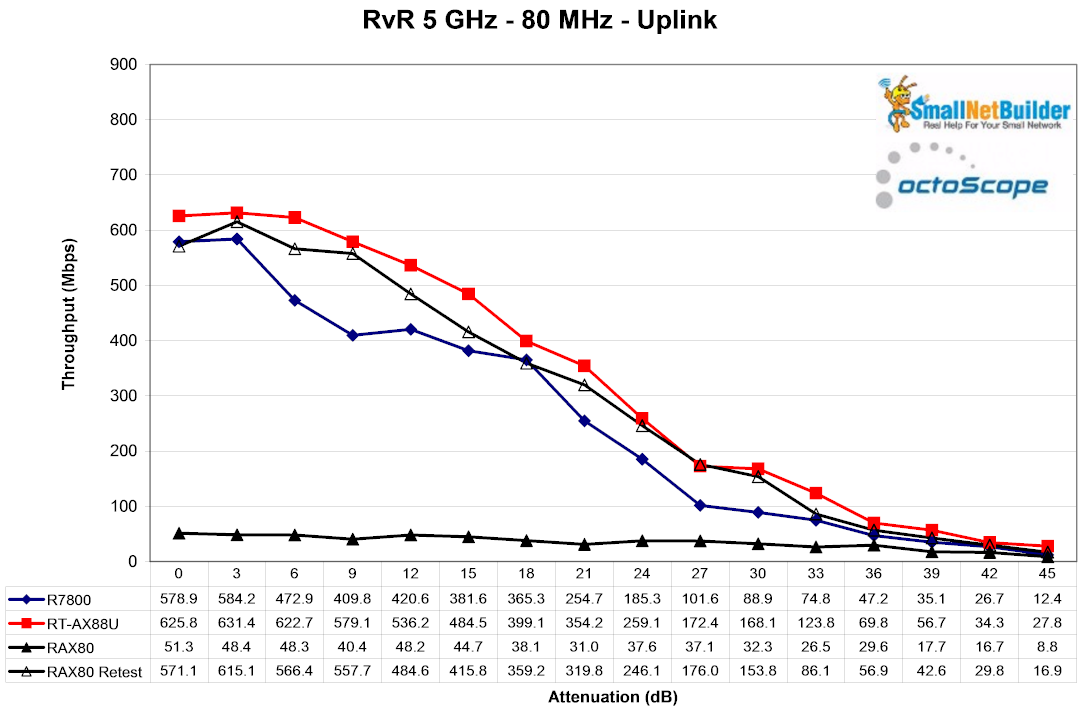
RETESTED RvR 5 GHz – 80 MHz – uplink
Which brings us to why you’d want to mess with buying a draft 11ax router at its most expensive and immature point in its life;160 MHz channel bandwidth. The downlink plot finally shows all three routers behaving as they should—sorta. The ASUS RT-AX88U again turns in the best showing at the higher signal levels (lower attenuation values). This time, however, its curve meets up with a competitor—the R7800—and then crosses under it until 33 dB of attenuation.
NETGEAR’s draft AX RAX80 peak throughput is only slightly lower than the ASUS’. But its curve falls off more quickly and remains below both other routers’ for most of the tested range.
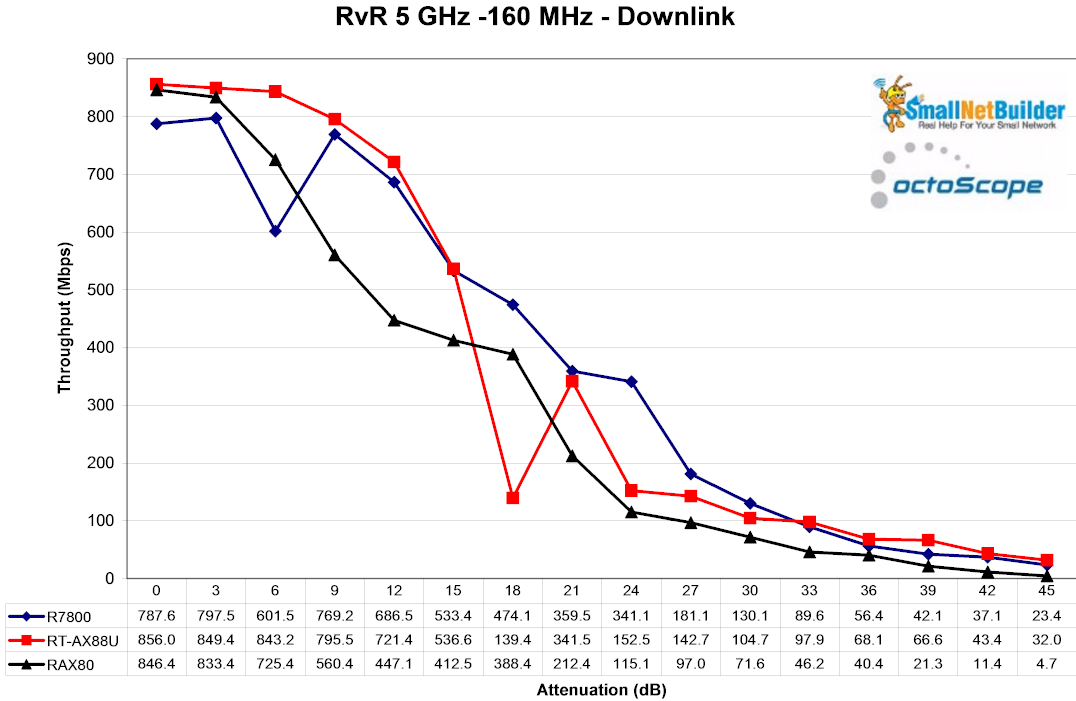
RvR 5 GHz – 160 MHz – downlink
For uplink, it’s hard to call a winner. But the third place performer again seems to be the RAX80.
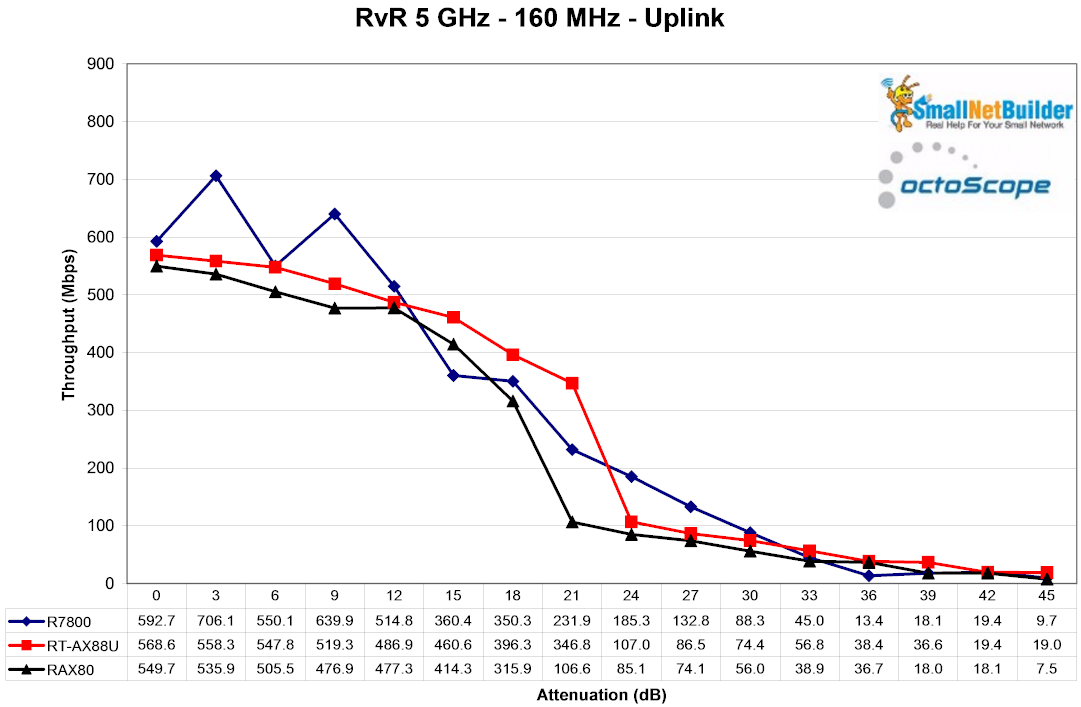
RvR 5 GHz – 160 MHz – uplink
Is 160 MHz Worth It?
As I’ve said probably too many times already, 160 MHz channel bandwidth is the main benefit draft 11ax routers can provide right now, if you have the Intel AC 9260 in your notebook. So how much benefit is that wider channel? The downlink comparison plot uses the best result for the R7800 (with HT 160 mode disabled) as a reference. The best case (0 dB attenuation) throuhput gains are 32%, 41% and 43% for the R7800, RAX80 and RT-AX88U, respectively. And if you follow the curves down, that throughput advantage is sustained for the ASUS RT-AX88U (if you ignore the dip @ 18 dB attenuation) and NETGEAR R7800 out to around 24 dB attenuation.
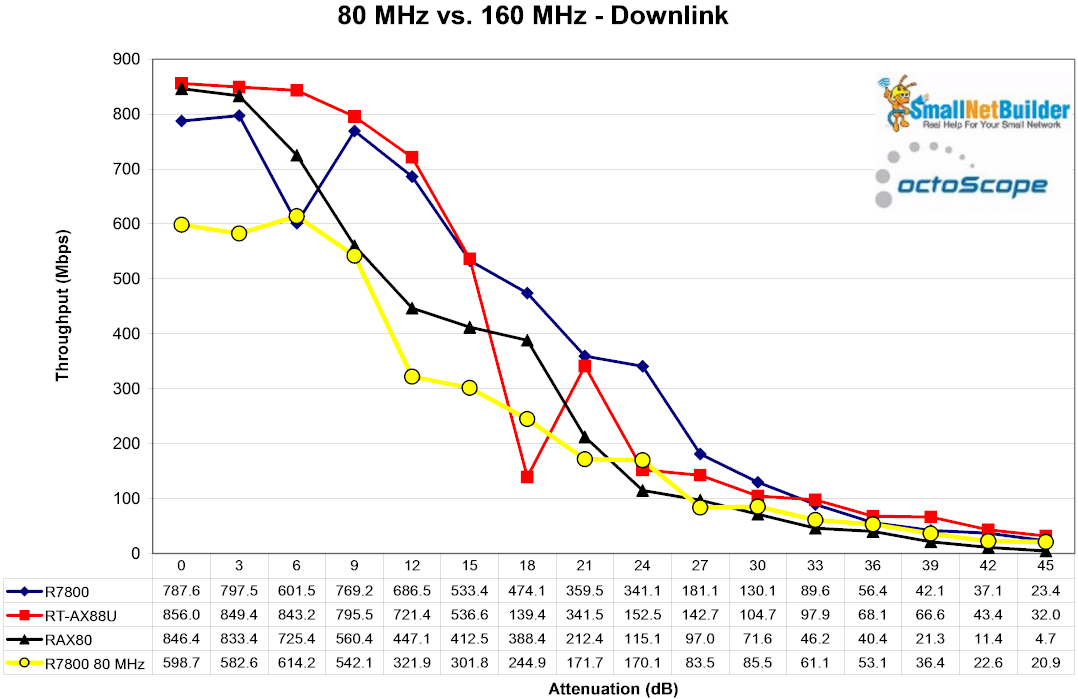
80 MHz vs. 160 MHz – downlink
For uplink, however, the plot shows there is little advantage to be had from the wider channel.
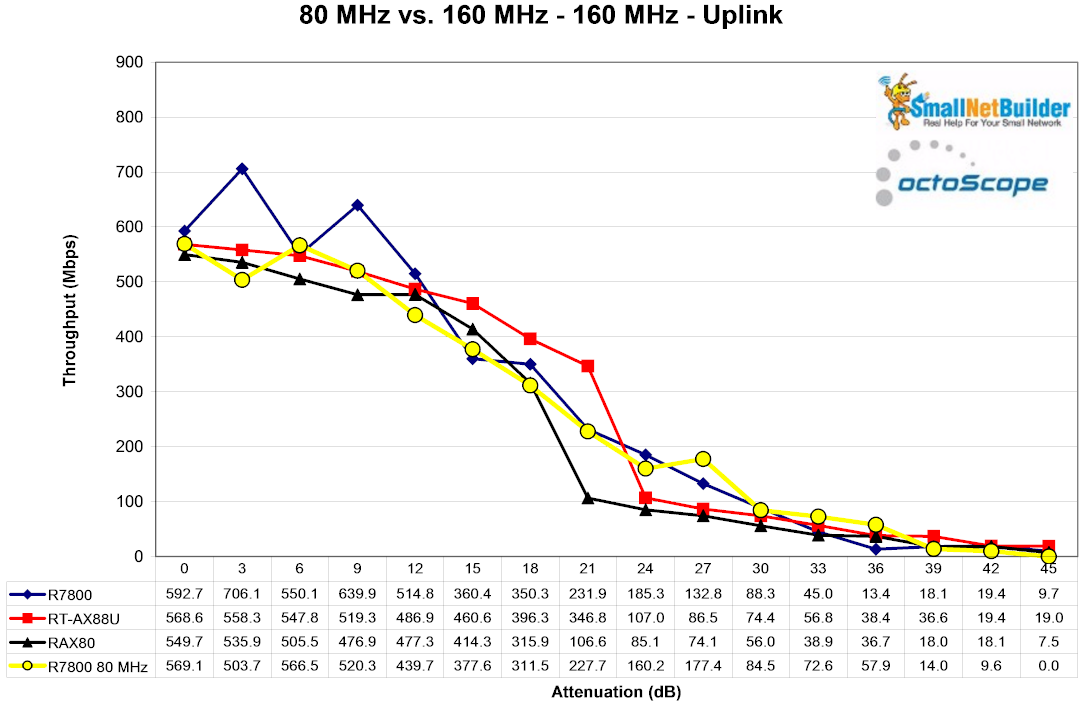
80 MHz vs. 160 MHz – uplink
Closing Thoughts
As I said at the start, this is not the definitive word on the performance of the two first-to-market Broadcom-based draft Wi-Fi 6 routers. Since they are both based on the same key Broadcom devices, I’d expect any significant performance differences I’ve found to eventually be reduced to be inconsequential.
Meanwhile, device makers, router makers, the IEEE ax Working Group and myself have much more work to do. But if I were considering parting with the $400 it takes to bring one of these home right now, I’d come away unconvinced by anything I’ve shown in this report.
